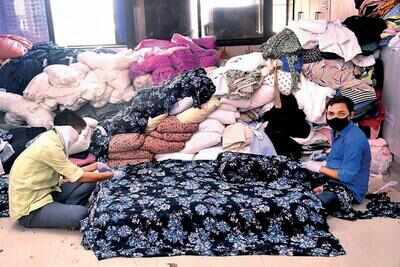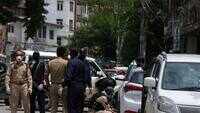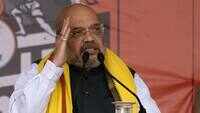
Surat: Even as the state government has relaxed Covid-19 norms for the commencement of industrial activity across the state, the two most important sectors — textile and diamond — are still languishing in the dark. Reason: Both the sectors are impacted by rules meant for ‘red zones’.
In a meeting with the trade associations and leaders of the textile and diamond sectors on Tuesday, municipal commissioner Banchhanidhi Pani clarified that no business activity will be allowed in the containment zones. This will impact about 55,000 textile shops in about 140 textile markets located in the city’s red zones.
However, diamond and textile units operating in non-containment or green zones will be allowed to function with 50% workforce and strict adherence to standard operating procedure (SOP) guidelines to contain spread of coronavirus.
On the other hand, the worst-hit under the restrictions is the diamond industry with most of its cutting and polishing units being located in the red zones of Varachha, Katargam and Central zone including the Mahidharpura and Varachha diamond markets. Not only that its lifeline, the Mumbai market, too is still under lockdown.
Regional chairman of Gems and Jewellery Export Promotion Council (GJEPC), Dinesh Navadiya said, “It is a confusing situation for the diamantaires whether to resume operation or not as not only are our own diamond markets besides many diamond units in the containment zones, the other bigger problem is that the Mumbai market is yet to reopen. Again, a majority of the diamond workers too have moved out of the city.”
Talking with TOI, municipal commissioner Banchhanidhi Pani said, “The textile and diamond stakeholders were given detailed information on the containment zones. Textile markets located in containment zones will not be allowed to open. There are 42 containment zones covering 16 lakh population in 24 sq km area. However, we have permitted textile markets in non-containment zones to open on odd-even formula.”
Pani further said that the industries will have to follow SOP guidelines. If positive cases get spiked in industrial areas, the units will be sealed once again. Guidelines issued to contain spread of coronavirus including sanitisation, compulsory wearing of face mask, social distancing among others will have to be followed strictly, he added.
Manoj Agarwal, president of Federation of Surat Textile Traders Association (FOSTTA) said, “About 90% of the textile markets are in the red zone and they are not allowed to commence operation. Textile markets are the key component of the textile chain and that it will impact the normal functioning of the textile sector in the coming days.”
Jitu Vakharia, president of South Gujarat Textile Processors’ Association (SGTPA) said, “Baring 15 textile mills, majority are in the non-containment zones. Our members have started preparations to re-start the mills in the next couple of days. Since the textile markets will remain shut, we will directly source fabric from the powerloom units.”
Ashish Gujarati, president of Pandesara Weavers association said, “About 40% of the weaving units in the city will start operation from Wednesday. Disinfecting activities are going on in the industrial areas in the non-containment zones.”
In a meeting with the trade associations and leaders of the textile and diamond sectors on Tuesday, municipal commissioner Banchhanidhi Pani clarified that no business activity will be allowed in the containment zones. This will impact about 55,000 textile shops in about 140 textile markets located in the city’s red zones.
However, diamond and textile units operating in non-containment or green zones will be allowed to function with 50% workforce and strict adherence to standard operating procedure (SOP) guidelines to contain spread of coronavirus.
On the other hand, the worst-hit under the restrictions is the diamond industry with most of its cutting and polishing units being located in the red zones of Varachha, Katargam and Central zone including the Mahidharpura and Varachha diamond markets. Not only that its lifeline, the Mumbai market, too is still under lockdown.
Regional chairman of Gems and Jewellery Export Promotion Council (GJEPC), Dinesh Navadiya said, “It is a confusing situation for the diamantaires whether to resume operation or not as not only are our own diamond markets besides many diamond units in the containment zones, the other bigger problem is that the Mumbai market is yet to reopen. Again, a majority of the diamond workers too have moved out of the city.”
Talking with TOI, municipal commissioner Banchhanidhi Pani said, “The textile and diamond stakeholders were given detailed information on the containment zones. Textile markets located in containment zones will not be allowed to open. There are 42 containment zones covering 16 lakh population in 24 sq km area. However, we have permitted textile markets in non-containment zones to open on odd-even formula.”
Pani further said that the industries will have to follow SOP guidelines. If positive cases get spiked in industrial areas, the units will be sealed once again. Guidelines issued to contain spread of coronavirus including sanitisation, compulsory wearing of face mask, social distancing among others will have to be followed strictly, he added.
Manoj Agarwal, president of Federation of Surat Textile Traders Association (FOSTTA) said, “About 90% of the textile markets are in the red zone and they are not allowed to commence operation. Textile markets are the key component of the textile chain and that it will impact the normal functioning of the textile sector in the coming days.”
Jitu Vakharia, president of South Gujarat Textile Processors’ Association (SGTPA) said, “Baring 15 textile mills, majority are in the non-containment zones. Our members have started preparations to re-start the mills in the next couple of days. Since the textile markets will remain shut, we will directly source fabric from the powerloom units.”
Ashish Gujarati, president of Pandesara Weavers association said, “About 40% of the weaving units in the city will start operation from Wednesday. Disinfecting activities are going on in the industrial areas in the non-containment zones.”

Coronavirus outbreak
Trending Topics
LATEST VIDEOS
City
 Covid-19: 67 cops test positive at District Police lines in Anantnag
Covid-19: 67 cops test positive at District Police lines in Anantnag  Shocking apathy in Srinagar: Suspected Covid-19 patient ‘dumped’ on the stairs of a hospital
Shocking apathy in Srinagar: Suspected Covid-19 patient ‘dumped’ on the stairs of a hospital  Maharashtra: Four migrant workers killed, 15 injured in bus-truck collision in Yavatmal
Maharashtra: Four migrant workers killed, 15 injured in bus-truck collision in Yavatmal  Amit Shah assures all help to Mamata Banerjee as Cyclone Amphan nears Bengal
Amit Shah assures all help to Mamata Banerjee as Cyclone Amphan nears Bengal
More from TOI
Navbharat Times
Featured Today in Travel
Quick Links
Kerala Coronavirus Helpline NumberHaryana Coronavirus Helpline NumberUP Coronavirus Helpline NumberBareilly NewsBhopal NewsCoronavirus in DelhiCoronavirus in HyderabadCoronavirus in IndiaCoronavirus symptomsCoronavirusRajasthan Coronavirus Helpline NumberAditya ThackerayShiv SenaFire in MumbaiAP Coronavirus Helpline NumberArvind KejriwalJammu Kashmir Coronavirus Helpline NumberSrinagar encounter
Get the app



